A commodity price index is a fixed-weight index or (weighted) average of selected commodity prices, which may be based on spot or futures prices. It is designed to be representative of the broad commodity asset class or a specific subset of commodities, such as energy or metals. It is an index that tracks a basket of commodities to measure their performance. These indexes are often traded on exchanges, allowing investors to gain easier access to commodities without having to enter the futures market. The value of these indexes fluctuates based on their underlying commodities, and this value can be traded on an exchange in much the same way as stock index futures.
Investment management is the professional asset management of various securities, including shareholdings, bonds, and other assets, such as real estate, to meet specified investment goals for the benefit of investors. Investors may be institutions, such as insurance companies, pension funds, corporations, charities, educational establishments, or private investors, either directly via investment contracts/mandates or via collective investment schemes like mutual funds, exchange-traded funds, or REITs.

Asset allocation is the implementation of an investment strategy that attempts to balance risk versus reward by adjusting the percentage of each asset in an investment portfolio according to the investor's risk tolerance, goals and investment time frame. The focus is on the characteristics of the overall portfolio. Such a strategy contrasts with an approach that focuses on individual assets.
Lipper Average also known as Lipper Index are a series of indices produced by Lipper, a subsidiary of Thomson Reuters, that establish benchmarks to measure the performance of a portfolio, or of various mutual funds and exchange-traded funds. They allow an investor, a portfolio manager, or an institutional investor to compare the performance of his/her investment portfolio against other, similar investments. Historical trends, strengths and weaknesses can be evaluated.
The S&P GSCI serves as a benchmark for investment in the commodity markets and as a measure of commodity performance over time. It is a tradable index that is readily available to market participants of the Chicago Mercantile Exchange. The index was originally developed in 1991, by Goldman Sachs. In 2007, ownership transferred to Standard & Poor's, who currently own and publish it. Futures of the S&P GSCI use a multiple of 250. The index contains a much higher exposure to energy than other commodity price indices such as the Bloomberg Commodity Index.

The Refinitiv/CoreCommodity CRB Index is a commodity futures price index. It was first calculated by Commodity Research Bureau, Inc. in 1957 and made its inaugural appearance in the 1958 CRB Commodity Year Book.
Fundamentally based indexes or fundamental indexes, also called fundamentally weighted indexes, are indexes in which stocks are weighted according to factors related to their fundamentals such as earnings, dividends and assets, commonly used when performing corporate valuations. Indexes that use a composite of several fundamental factors attempt to average out sector biases that may arise from relying on a single fundamental factor. A key belief behind the fundamental index methodology is that underlying corporate accounting/valuation figures are more accurate estimators of a company's intrinsic value, rather than the listed market value of the company, i.e. that one should buy and sell companies in line with their accounting figures rather than according to their current market prices. In this sense fundamental indexing is linked to so-called fundamental analysis.
Thomson Reuters Lipper is an American financial services firm. Founded in 1973 as Lipper Analytical Services, it was acquired by Reuters in 1998.

A bond index or bond market index is a method of measuring the investment performance and characteristics of the bond market. There are numerous indices of differing construction that are designed to measure the aggregate bond market and its various sectors A bond index is computed from the change in market prices and, in the case of a total return index, the interest payments, associated with selected bonds over a specified period of time. Bond indices are used by investors and portfolio managers as a benchmark against which to measure the performance of actively managed bond portfolios, which attempt to outperform the index, and passively managed bond portfolios, that are designed to match the performance of the index. Bond indices are also used in determining the compensation of those who manage bond portfolios on a performance-fee basis.
The S&P/ASX 300, or simply, ASX 300, is a stock market index of Australian stocks listed on the Australian Securities Exchange (ASX). The index is market-capitalisation weighted, meaning each company included is in proportion to the indexes total market value, and float-adjusted, meaning the index only considers shares available to public investors.
The Deutsche Bank Liquid Commodity Index (DBLCI) was launched in February 2003. It tracks the performance of six commodities in the energy, precious metals, industrial metals and grain sectors. The DBLCI has constant weightings for each of the six commodities and the index is rebalanced annually in the first week of November. Consequently, the weights fluctuate during the year according to the price movement of the underlying commodity futures.
In May 2006, Deutsche Bank launched a new set of commodity index products called the Deutsche Bank Liquid Commodities Indices Optimum Yield, or DBLCI-OY'. The DBLCI-OY indices are available for 24 commodities drawn from the energy, precious metals, industrial metals, agricultural and livestock sectors. A DBLCI-OY index based on the DBLCI benchmark weights is also available and the optimum yield technology has also been applied to the energy, precious metals, industrial metals and agricultural sector indices. Like the DBLCI, the DBLCI-OY is available in USD, EUR, GBP and JPY on a hedged and un-hedge basis. The DBLCI-OY is rebalanced on the fifth index business day of November when each commodity is adjusted to its base weight. The DBLCI-OY is also listed as an exchange-traded fund (ETF) on the American Stock Exchange.

S&P Dow Jones Indices LLC is a joint venture between S&P Global, the CME Group, and News Corp that was announced in 2011 and later launched in 2012. It produces, maintains, licenses, and markets stock market indices as benchmarks and as the basis of investable products, such as exchange-traded funds (ETFs), mutual funds, and structured products. The company currently has employees in 15 cities worldwide, including New York, London, Frankfurt, Singapore, Hong Kong, Sydney, Beijing, and Dubai.
The Dow Jones Sustainability Indices (DJSI) launched in 1999, are a family of indices evaluating the sustainability performance of thousands of companies trading publicly, operated under a strategic partnership between S&P Dow Jones Indices and RobecoSAM of the S&P Dow Jones Indices. They are the longest-running global sustainability benchmarks worldwide and have become the key reference point in sustainability investing for investors and companies alike. In 2012, S&P Dow Jones Indices was formed via the merger of S&P Indices and Dow Jones Indexes.

In finance, a stock index, or stock market index, is an index that measures the performance of a stock market, or of a subset of a stock market. It helps investors compare current stock price levels with past prices to calculate market performance.
The Refinitiv Business Classification (TRBC) is an industry classification of global companies. It was developed by the Reuters Group under the name Reuters Business Sector Scheme (RBSS), was rebranded to Thomson Reuters Business Classification (TRBC) when the Thomson Corporation acquired the Reuters Group in 2008, forming Thomson Reuters, and was rebranded again, to The Refinitiv Business Classification (TRBC), in 2020. Since the creation of Refinitiv in October 2018, TRBC has been owned and operated by Refinitiv and is the basis for Refinitiv Indices.
Industry classification or industry taxonomy is a type of economic taxonomy that classifies companies, organizations and traders into industrial groupings based on similar production processes, similar products, or similar behavior in financial markets.
The Refinitiv Equal Weight Commodity Index is a major US barometer of commodity prices. The index comprises 17 commodity futures that are continuously rebalanced: cocoa, coffee, copper, corn, cotton, crude oil, gold, heating oil, live cattle, live hogs, natural gas, orange juice, platinum, silver, soybeans, Sugar No. 11, and wheat.
Indxx, Inc. is a global diversified financial services firm. Founded in 2005 by Mexx Co-founder PK Sen Sharma, the company has offices in New Delhi, India; New York, USA; Miami, USA and Prague, Czech Republic. It currently has over 100 employees spread across four main business groups: Indxx Indices, Custom Indices, Client Indices and Equity Basket Calculation.

Solactive is a German provider of financial indices based in Frankfurt. The company develops, calculates, and markets cost-efficient indices over several asset classes, including equity, fixed-income, and commodity indices. Solactive also engages in the development and branding of complex strategies, which are not based on traditional underlyings such as stocks and bonds, but instruments like funds, life insurance products, or basket of currencies.